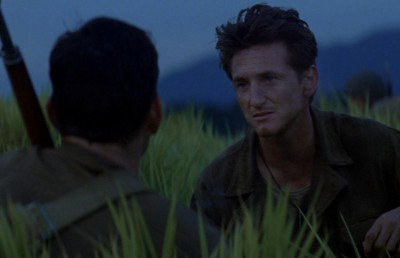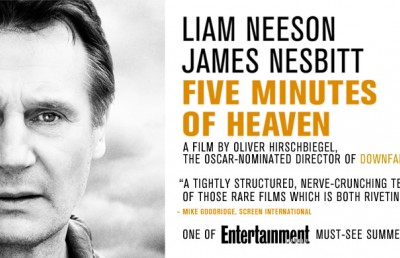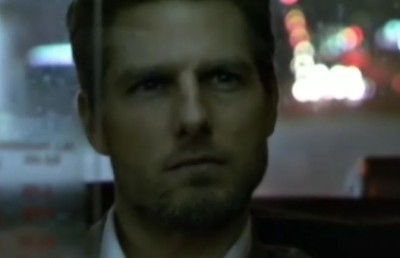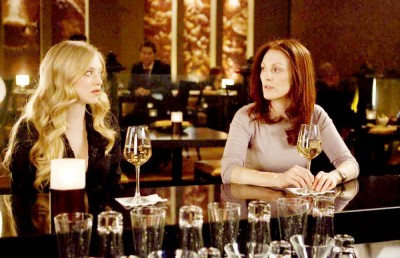Eyes Wide Shut: Dream Movie
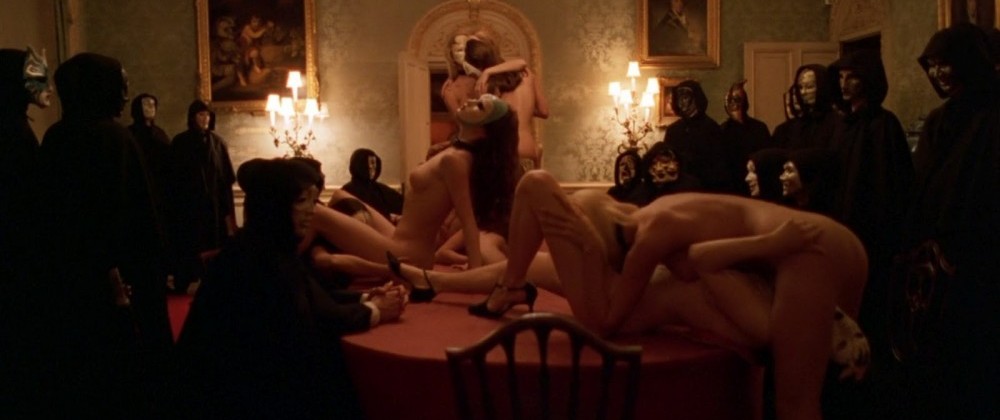
Introduction
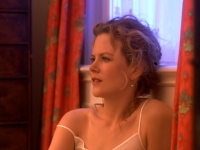
Eyes Wide Shut is Stanley Kubrick’s unappreciated masterpiece. The film has largely been overlooked as a giant of the medium and it has been misunderstood by the general audience, film critic and film theoretician alike.
Great art, of which I claim this film to be an example, is richly layered and replete with meaning. Indeed it creates and promotes the opportunity to increase its meaning and its capacity to be analysed and interpreted. Unlike non-fiction its revelations about the human condition are not always direct or limited. The form the art work takes should permit it to contain genuine insight which allows for ongoing interpretation. The insights we can glean from Freudian analysis of Shakespeare are not because Shakespeare read Freud (obviously) but because he was able to represent truths about the psychology of humanity in his art which later could be understood and articulated using new conceptual tools. By tapping into fundamental truths, perhaps even unconsciously (necessarily so even), and rendering them in manifest form in such a way that the nuances, obscurities and symbolic nature of the insights are authentic, the content of the artwork can lend itself to being interrogated in numerous ways using an apparently infinite variety of theories. It is for this reason that reading any amount of analysis on a great work of art, whilst enriching that art work for us, can never compare to experiencing the work of art itself. This characteristic is often confused with the notion of ambiguity which is often argued to be a worthy end goal of art. However, a work of art which is completely ambiguous and totally open to any interpretation is not rich in meaning but actually has no meaning. To mean everything is to mean nothing. With this in mind we can also find ourselves falling into the trap of thinking that all interpretations are equally valid – by this I mean that they produce equal explanatory power about what the work of art can reveal to us. Kubrick’s films are necessarily obscure, they are purposefully nuanced and symbolic. This means that they render themselves as easily open to less useful analyses as they do to more insightful ones. The amount of misinformation, or should I say less useful theories, about what Eyes Wide Shut is about is astonishing (one can find on the Internet a proliferous set of theories ranging from the film being purposefully about nothing, apparently Kubrick’s final big joke on the world, to the film being about the Illuminati!). This does not mean to imply that I think there is only one interpretation of the film, exactly the opposite, but rather that coming across interpretations which genuinely help to reveal the sagacity of the film is difficult and requires us to develop more critical opinions in order to sort the proverbial wheat from the chaff.
Stanley Kubrick’s films are notoriously difficult to understand. They are both slow moving and obscure. It seems to me that Kubrick was entirely uninterested in manipulating emotions and consciously avoided doing so. He had little interest in ‘moving’ an audience for its own sake. Emotion was important to him but served a deeper purpose than simply bringing a viewer to tears or jubilation. Kubrick was not interested in his films explaining themselves, by telling the audience how to react or what they should be learning. This marks him in stark contrast to Spielberg, for example, but also to almost every other major director working in the mainstream, who explicitly attempts to send viewers on an emotional journey to which they can submit themselves. They are there to be passively entertained. A Kubrick watcher by contrast, is demanded to be active. It is in this light that I would argue Robert Kolker places Kubrick’s films in the category of what he calls the open text, “The process of open-endedness is not necessarily synonymous with ambiguity… Ambiguity is presented as indefinite [and] can provoke passivity… Openness demands activity and integration… The open text provokes, indeed demands participation, questioning, working with the film’s visual and aural structures.” [1] The audience is challenged to be engaged in order to glean meaning from the film, with the promise that if we are able to do this, the richness and knowledge we find in Kubrick’s works vastly outstrips the ‘easier’ films we are more used to watching. Kubrick, like other truly great artists in other media, changes our lives. He sears images and ideas into our memories. His films are “both corrosive and corrective. They open our eyes.” [2]
Kubrick was a true master of the medium of film and treated it as an art form, something which reveals to us aspects of the human condition. More precisely he projected meaning and content through images and it is through examination of images, rather than the words of his characters or the plot (usually a secondary issue for Kubrick, again in contrast to perceived wisdom that story is everything), that the ideas and themes are revealed to us. For Kubrick, form and content are never really separate. [3] His shot compositions are as aesthetically pleasing as his mise-en-scène is intellectually rigorous and complex. ‘Breaking in’ to a Kubrick film can be compared to analysing a dream. Freud described in The Interpretation of Dreams how we conduct a degree of dream work to conceal the latent repressed unconscious thoughts that find partial escape from censorship in our sleep, the wall between conscious and unconscious now a translucent window. This dream work consists of various ways of disguising the latent content including representing these repressed desires and wishes in visual and symbolic forms. Therefore the process of understanding the true latent meaning of a dream involves an analysis of imagery. [4] This analogy is particularly apt for Eyes Wide Shut which is adapted from a book by Arthur Schnitzler called Traumnovelle. Schnitzler wrote at the same time as Freud in Vienna and they became close friends. His work was characterised by its piercing and controversial psychological content which led Freud to write to Schnitzler stating “you have learned through intuition – though actually as a result of sensitive introspection – everything that I have had to unearth by laborious work on other persons.” [5] The process of revealing the implicit latent content in a Kubrick film, as in a dream, is a difficult one that requires insight, reflection and patience but which ultimately offers us value worthy of this effort and helps us to understand ourselves better.
Eyes Wide Shut by way of The Shining
By reviewing Kubrick’s oeuvre we can find themes which are recurring and which may offer us insight into unlocking his films. Eyes Wide Shut covers some very familiar ground, although in an entirely different and more nuanced way, to The Shining, both investigating the nature of gender politics within the context of a relationship and the effects this has on the characters. To over simplify for the purposes of expediency, The Shining charts the narrative, symbolised via the attributes of the horror film, of Jack’s desire to re-establish patriarchal rule over his family when he feels this power is threatened. He feels he needs to “correct” them (as per the words of the previous caretaker who killed his family, Grady, who gives Jack advice on how to re-assert himself over his unruly family) and he does so using the inherent tool which he has at his disposal as a man, superior physical strength. This manifests itself in violence towards his wife and child which escalates into an attempted murderous rampage.
Jack’s attitude is clearly represented in the film as an archaic one which is tied to the past. We discover that at the end of the film he has a doppelganger from the 1920s and Grady (along with the bartender, Lloyd) with whom he discusses how he should act is an apparition of a hotel employee from previous years. By contrast, the future of the male psyche is represented by the young boy, Jack’s son, who sees this desire for patriarchal dominance as alien and horrific, something to distance himself from. Jack, along with his ideas, is literally frozen in time at the end of the film as his attempts to regain his sense of empowered masculinity fail. Far from being misogynistic as many have claimed, this reading of the film shows it to be a progressive representation of gender politics.
Bruno Cornellier points out that “Kubrick’s obsession about sexual politics within western civilisation predates Eyes Wide Shut by many years, even decades. From ??Dr. Strangelove??’s (1964) ironic account of nuclear warfare and technology as an empowering substitution to man’s impotence, to ??Full Metal Jacket??’s (1987) US military training and invasion of Vietnam as symbolic signifiers of the repression of mothering and of the female other, male self-destructive instincts constitute a major subtext within his films from the 1950s onwards.” [6]
Taking this theme with us as we move on to Eyes Wide Shut we will see that Jack from The Shining and Bill from Eyes Wide Shut share a similar sense of male angst, although deal with it in completely different ways – the psychopath versus the essentially good husband and father. We shall see how it presents “an obsessive and – for its central character – unsuccessful quest for ways to maintain male sexual dominance and overcome the upheavals caused by the shifting relationships between genders.” [7]
Analysis of the opening and closing shots
It is tautological to state that a film covers the journey between the first and final shots but in the case of Eyes Wide Shut these two images which bookend the picture offer us incredible insight into how the central theme of the film plays out.
The opening shot of the film sees Alice shed her clothes as she prepares to get ready for a night out. The image is striking. We, the audience, are clearly positioned as voyeur. We view Alice through the next room from behind. As she begins to slip off her dress we are struck by the sense of anticipation that Kubrick will give us upfront –the guilty pleasure we have been expecting which “at once fulfils the desire of the audience to see Nicole Kidman naked” [8] before even a single word has been uttered. Alice, at this stage, exists for us only in so much as she is there to be looked at, the controlled subject of what Laura Mulvey termed the male gaze. [9] Her existence is limited to what we see her as, an object of scopophilia – Freud’s theory of the pleasure of looking, and in doing so objectifying. Even her opening line positions her as a willing recipient of this, “How do I look?”. She is also standing in front of a mirror – for the non layman reader familiar with Mulvey’s work we might see this as further evidence of her unempowerment with even her own image of herself confined within the context of Lacan’s symbolic order of the male defined world.
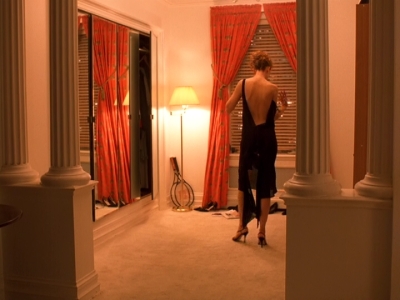
Closer inspection of the image reveals that the curtains and blinds are open at night time as she stands in front of the window, thus submitting herself to the voyeurism of others within the films own world. It is worth noting here that this image offers us the slightest hint that she is aware, and perhaps even entices the male gaze. There is an ambiguous theme running throughout the film that Alice understands the female effect on male fantasy and even manipulates it, perhaps unconsciously, for her own benefit. I will return to this idea later.
Jump to the final shot of the film. Again, it is a shot of Alice, which in itself is interesting given that we have spent the majority of the film following Bill. This time the image is a close up of her face. She is wearing no make up, she wears her hair up for practical purposes, she is wearing glasses and a thick coat and jumper. In short she is not any longer the subject of the voyeuristic camera. Furthermore it is in this final scene when she confirms for Bill that they can continue as a couple following all that has happened throughout the film. She goes on to tell him that there is something they need to do and when he questions her as to what this is, the camera cuts to her for the final image of the film in which she says “Fuck.” [10] So now we have a situation whereby Alice is not only the one in control of whether the relationship continues or not, she has the veto, but she is also in control of their sex life. She gets to decide when they have sex and indeed whether they make love or fuck. She has gone from being solely the object of male fantasy, under the control of the voyeuristic male gaze, unempowered and defined only by her “to-be-looked-at-ness”, [11] to being the sexually dominant and empowered party in the relationship. The film effectively charts the unconscious shift in power between a loving couple.
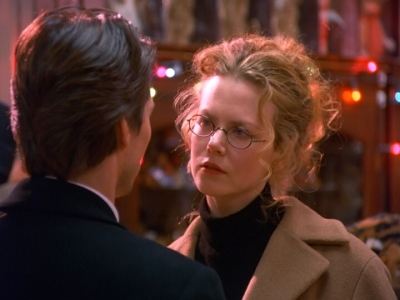
A Sex Odyssey
The prevention of an erotic satisfaction calls up a piece of aggressiveness against the person who has interfered with the satisfaction, and this aggressiveness has itself to be suppressed in turn…which is transformed into a sense of guilt.” [12]
Sigmund Freud
This power change we see in the film is essentially initiated by the revelation by Alice to Bill of her fantasy of running away with another man with whom they crossed paths on holiday a year earlier. Alice’s confession is apparently brought about by “Bill’s adoring view of her as a prized social trophy for the public admiration of others.” [13] Bill is recognisably shocked by this and clearly seems to feel a sense of anger, betrayal and hurt. Bill’s sense of self identity has been shaken as well as his sense of being able to compartmentalise and stereotype Alice – his naive words to her, “I’m sure of you” [14] and the sexist remark “women…don’t think like that” [15] now undermined by her assertion of herself as a subject in her own right. He is called away from the discussion with Alice by a patient and thus begins his journey in which he attempts to re-empower himself and regain his sense of masculinity through a real life sexual liaison with another woman which would give him some sense of retribution for the imagined affair recounted to him by his wife. “Like Jack Torrance in The Shining, he expresses a latent male urge to blame his wife for all his inadequacies as a husband and father.” [16]
On this journey Bill encounters a who’s who of stereotypical male fantasy objects and situations: the vulnerable woman requiring something more from him than just sympathy who declares her love for him (who also acts as a challenge to Bill if he intended psychologically to blame the man of Alice’s fantasy for her imagined infidelity – Bill himself is now that man for Marian); a beautiful and educated prostitute; a young sexually assertive teenage girl who implies both that she is propositioning him and that she knows where he is going (Somerton); a gay flirtatious hotel reception clerk; an orgy involving numerous beautiful women, etc. However, in none of these encounters is Bill able to consummate a sexual conquest and in each failure he is further symbolically emasculated. It is very often Bill himself who chooses to prevent these situations from developing further, mirroring his rebuffing of the sexual invitation from the two models at Ziegler’s party but this time with a sense of personal identity at stake.
I do not think Kubrick intends for simple moral judgements to be passed on his two main characters. Certainly they are both imperfect and capable of immaturity and a desire to hurt one another. Too often I have read critiques of Bill’s behaviour, redolent as it is of over simplistic stereotypes of masculine and feminine, which imply he simply gets what is coming to him from Alice. However, I see Bill as an essentially decent man who earlier assured Alice that he did not sleep with the girls at Ziegler’s party because, in his words, “I happen to be in love with you and because we’re married and because I would never lie to you or hurt you.” For an enlightened person, surely this is a perfectly reasonable response? What else could he say without lying? Indeed, he stays true to this throughout the course of the film. Alice’s incredulous response, “Do you realize that what you’re saying is that the only reason you wouldn’t fuck those two models is out of consideration for me, not because you really wouldn’t want to?” [17] is demonstrated to be hypocritical given her subsequent recounting of her fantasy in which she would have left him completely for someone she had never even spoken to. I do not mean to imply instead that Alice should be viewed as the bad person in the relationship, rather that both of them are flawed and complex and that the moral, social and sexual assertions that both of them make are open to question.
Alice’s second revelation, the recounting of her dream in which she makes love to lots of different men whilst laughing at Bill, is in his mind further evidence of her treachery. This gives Bill renewed impetus to make good on one of his opportunities to reassert his sense of masculinity, now challenged a second time by Alice and under fire from numerous other angles too, but again he fails to do so. He encounters various psychological barriers to his sexual consummation including its link to what Freud calls the death drive. The danger of sex is registered on various occasions and Bill’s life, as well as those of others, are threatened (being discovered as an imposter at the orgy, the subsequent death of Amanda who he visits at the morgue, being trailed on his journey by suspicious men, discovering that the prostitute he nearly slept with has HIV, etc.). More importantly than that, however, is the representation of other men in the film and Bill’s marked contrast to them.
Bill’s quest for empowerment time and time again leads to further emasculation. Tom Cruise’s movie star, omnipotent persona works well here in underlining Bill’s lack of such things – a perfect example being when he is the subject of homophobic abuse on the streets of New York to which he has no effective response. Indeed, as Hunter Vaughan points out, Bill himself becomes the object of the objectifying look in the film – most notably when he is unmasked and threatened with nakedness by a mansion full of faceless eyes, “The film not only reveals the star (Cruise) as an object of the gaze, but it reveals his character (Bill) as a weak and incomplete ego, thus castrating him yet again (ough!).”
Bill is given an alternative to this impotence but it is not an appealing one. The men who Bill encounters on his journey are almost entirely debased and depraved: the man in the costume shop ready to pimp out his own daughter; the youths on the street who believe the best way to insult someone is to question their sexuality; the faceless demons willing to kill him and sacrifice the life of a woman at the orgy and, of course Ziegler. Ziegler, who happily sleeps with a prostitute upstairs at his own party while his wife entertains downstairs; who displays a complete disregard for this woman’s well being when she suffers from a drug overdose; who recounts the death of the woman at the orgy without any sense of pity or remorse. Ziegler represents “an aging male order that ruthlessly defends the ugly, primitive myth of its own social and sexual authority in a world where that power is being challenged by a younger generation of successful men with chiselled physiques and of liberated women with buffed self-confidence.” [18]
In the film Bill’s choices seem clear. He either succumbs to his desire for re-masculization and a sense of empowerment that his wife took from him, and in doing so he debases himself, or he remains emasculated by not consummating this fantasy. Alice is empowered as a result of his loss and he cannot reinstate his dominance on terms which are ethically acceptable to him. His new knowledge of the facade of gender representation in society acts as the forbidden fruit – he cannot re-establish his ignorance but is torn and conflicted due to the personal injury this knowledge does to him.
Fantasy and Reality
Bill is presented with these choices, both unappealing, which throws him into a state of personal conflict. The film suggests that the binary options he now finds himself with are as a result of his personal immaturity, manifest in his difficulty in separating fantasy from reality.
Not only does he perceive Alice’s fantasy as akin to her having an actual affair, but his own fantasy life seems incredibly limited by comparison. Her fantasy life seems to be rich and indeed full of internal conflict, perhaps indicative of the authenticity of Alice and her ability to be in touch with her inner life and representative of the contradictions of unconscious desire. However, Bill struggles in his attempts to “construct and enter his own.” [19] He claims to have no fantasies related to his patients at work who he regularly sees naked, something Alice does not believe but which, based on the rest of the film, may be right. His encounters are the stuff of generic, superficial, stereotypical male fantasy but he does not seem to have his own fantasy outside of this, except perhaps for a fantasy of empowerment – “that is just the kind of hero I can be sometimes.” [20] This further indicates his struggle to separate the two. As it happens we are made aware visually of a fantasy Bill has, but it is not about him, it is about Alice having sex with another man. His own fantasy life is built around hers and it taunts him throughout. The navy man wears the uniform Cruise himself helped to identify in culture as virile via his role in Top Gun – so in a self-reflexive manner Bill’s younger, cooler self, the ego ideal, has usurped him.
The nature of the human condition is such that we can only perceive the world through our senses. These perceptions pass through our brains and are ‘theory soaked’ [21] with our own views, assumptions, concepts, prejudices and desires in order to make any kind of sense or meaning of them. This theory soaking process involves attaching our fantasies to these perceptions. Alice is aware of her fantasies as being just that. They remain in her head or perhaps articulated through speech but she is aware they are not reality. Bill is required to live out his unconscious fantasy life which, when turned into manifest form, is unappealing, ambiguous and full of inner conflict for him. Bill struggles throughout to make sense of the world around him as he loads it with paranoia – is the person following him down the street really dangerous? Is Ziegler telling him the truth? And so on. Kubrick leaves these questions unanswered and ambiguous for the audience too. We find ourselves struggling with the same issues Bill does. Fantasy is a necessary part of interpreting the world but this means, for the subject at least, that the perceived world is never really free from fantasy and separating this from objective reality is an extraordinarily hard process. Indeed, at the extreme, it is impossible.
You will have noticed by now that by the term fantasy I mean not just what we might consider as imagery we actively create for ourselves which represents our conscious wishes and desires but also any interpretation of the world that we have that does not correspond with reality. The key here being that we do not recognise it as fantasy or interpretation. We incorrectly believe it to be simply our perception of reality.
Addressing the critics cited earlier, who said that Manhattan does not look like it does in real life, I would agree – but this was intentional.
Kubrick lends it an eerie dreamlike presence. He “keeps intact the novella’s implication that the nocturnal adventures were nothing more than shadows of his character’s unconscious.” [22] Bill has “a waking dream,” [23] furthering the confusion for the audience between fantasy and reality.
Alice’s awareness?
Kubrick throws some curve balls at the audience in this regard. Alice recounts her dream of sleeping with numerous men right as Bill gets home from the orgy and both these episodes end in Bill being dressed down in front of an audience. Does Alice know where he has been? Even if not, does she know the emasculating effect she is having on Bill by her sharing of her fantasies and dreams? At one point after her first revelation, Kubrick ‘breaks the fourth wall’ by having Nicole Kidman look directly at the camera, at the audience. There is another striking scene in which Alice and Bill begin foreplay in front of the mirror. Alice admires herself before Bill approaches her and starts to kiss her. Even as he does she remains transfixed on their reflection as if she is cognisant of her power to entice, mesmerized by it. “She is the onscreen voyeur.” [24] Is she aware of the male gaze? Is she challenging it? Does her awareness allow her to control or manipulate the supposed power it holds? The functional narrative of Eyes Wide Shut suggests that she does not know about Bill’s escapades until he tells her but the images conjure fantasies for the audience which makes us consider otherwise. In this respect the film works as complementary to Hitchcock’s Vertigo in its scrutiny of the voyeuristic nature of the camera and the implications for gender representation. Hunter Vaughan examines the analysis of the gaze in Eyes Wide Shut and concludes that “by embracing the “gaze” (as well as other fundamental concepts of feminist criticism) and using it self-consciously, both by revealing its limits and by making it both subject and object of the film, Kubrick reveals just how profoundly capable cinema is of acknowledging, manipulating, and subverting the patriarchal traditions of Classical Hollywood.” [25] Alice stands in for Kubrick in the film – acting as his vessel to launch a challenge to the power of the male gaze.
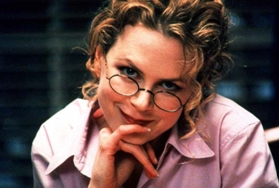
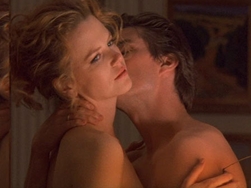
A Contemporary Film
Kubrick had previously stated that he had a desire to make a contemporary story “that finally gave a feeling of the times, psychologically, sexually, politically and personally. I would like to make this more than anything else, and it’s probably going to be the hardest film to make.” [26]
On its release Eyes Wide Shut was sighted by many as slow and old fashioned. How could it be contemporary when Kubrick had not even visited Manhattan in years and unconvincingly constructed it in a sound stage in England? The critics missed the point. Eyes Wide Shut is contemporary. It takes the basic themes of Traumnovelle and adapts it from its early twentieth century Vienna setting to offer insight into the post-feminist gender politics of a modern relationship.
Jonathan Rosenbaum describes Eyes Wide Shut to be the “closest thing in [Kubrick’s] work to a happy ending.” [27] Kubrick seems to imply that if Bill and Alice can be open and mature enough, individually and as a couple, to identify the unavoidable confusion of fantasy and reality, then they can salvage what might have been an untenable relationship.
Whether interpreted as happy or not the ending of Eyes Wide Shut demonstrates that Kubrick is interested in interrogating a relationship and understanding and revealing the human and social insights that can be revealed – from the micro to the macro. The film suggests it may be impossible to have a genuinely equal and intimate relationship. The human condition is such that as much as we love someone, we have unconscious repressed fantasies which contradict our benevolence towards them. These include desires related to empowerment and of wanting to hurt the person closest to you, to take revenge on them for (perceived, actual or imagined) wrongs they have done to you. This is the great challenge to intimacy revealed to us as inherently due to the existence and power of the unconscious. If we cannot ever really know and be honest with ourselves, how can we with someone else? This insight means that gender politics and the battle for power exist in spite of how real our respect and love are, how well meaning our intentions are, or what our conscious feelings are about equality in a relationship.
Kubrick tells us that gender politics are inescapable. The struggle and failure to delineate between fantasy and reality is inevitable and this will lead inexorably either to a shift in sexual power between men and women in contemporary western society, or to the restoration of a more brutal, harsher patriarchal world (represented by Ziegler). Indeed it seems these two worlds will compete with each other. The power shift is a result of Bill’s inner conflict and inability to attain a sense of masculinity without betraying his progressive sexual self-image and disrespecting Alice. It appears that she also experiences a degree of inner conflict resulting from her power gain being at his expense. From her perspective, it is unfortunately required that he is emasculated. Lee Siegel notices a beautiful, subtle moment in the film which highlights this perfectly, “the way [Kubrick] has Kidman stroke Cruise’s head after she tells him her violent second fantasy, as if she is taking a maternal pity on the man whom she, as the furious lover, cannot help tormenting.” [28]
The film asks us to think about the nature of morality when it comes to the unconscious. Freud tells us that we should “bear in mind Plato’s dictum that the virtuous man is content to dream what a wicked man really does… Actions and consciously expressed opinions are as a rule enough for practical purposes in judging men’s characters.” [29] Whilst we might take comfort in reminding ourselves that neither Bill or Alice actually cheat on each other and are essentially decent caring people, their ability to hurt one another is real and significant. It takes real maturity to gain a degree of self realisation that allows for an adequate separation of fantasy from reality and to control and limit, via this awareness, the damaging effects of the wishes and desires of the unconscious on those we love – “No dream is ever just a dream.” [30]
Kubrick is clear that maturity and openness may allow us a degree of self realisation that will enable the potential for, not just the salvation of the relationship, but a renewed, closer and more fully aware connection. Bill has managed to challenge his own “antiquated concept of “manhood”” [31] and no longer has a driving desire to be part of the Ziegler defined world. John Armstrong’s conclusion to his book (Conditions Of Love: The Philosophy of Intimacy) appears to be rather apt in describing the positive aspect of the ending of Eyes Wide Shut, “The experience of love has to begin outside of maturity; it’s just that, if a relationship is to last, if love is to survive and develop over an extended period, we need to bring to the relationship a set of qualities quite different from those which took us into it in the first place… The trajectory of love necessarily requires some development in the attitudes and feelings of the lovers.” [32]
Despite the progressive agenda charted by the film and the fact that “Kubrick climaxes the [film] by turning Alice into the most psychologically complete character found in any of his films, one whom he allows to speak his voice… [and who] becomes the strongest female presence created by Kubrick in any of his films,” [33] the film is very male focused. It largely calls the viewer to see the world through Bill’s eyes rather than Alice’s – charting the existential angst of the loving and progressive male who cedes power to his partner to save the relationship. This calls into question the ability to describe the film as pro-feminist even though it results in female empowerment, although as discussed Kubrick implies that this power shift has been, perhaps unconsciously, instigated by her, and based on her new found sense of identity.
Final Thoughts
If the auteur theory of film implies that the director has a consistent philosophy and worldview which he or she explores in every film they make (irrespective of genre or plot), and that the core content of the film represents the directors creative vision in this regard, then the analysis in this essay argues for Eyes Wide Shut to be viewed clearly as part of Kubrick’s larger body of work (as the auteur theory of film analysis would predict) rather than as an outlier. According to Hans Feldman in his essay,” Kubrick and his Discontents,” [34] “Kubrick’s films… seem to build from Freud’s analysis of the discontent of Western civilization [see Freud’s Civilisation and its Discontents] which erupts from its failure to acknowledge the primal, instinctual bestiality (the id) of ‘Man’.” [35] I would add that Kubrick is at pains to emphasise in all his films that there is no ideal, or even comfortable, solution for this problem. Bruno Cornellier says that Kubrick “constantly struggles to underscore…the alienating structures of civilisation’s codes of conduct upon human identity, repressed fantasies and unconscious desires. In this context, Eyes Wide Shut embodies a clear attempt to provide women with subjectivity and with fantasies, and to reveal the deceit of man’s claim to power and domination.” [36]
Eyes Wide Shut is richly layered with ideas and secondary themes and I have only scratched the surface. Indeed I think every scene is so rich with ideas one could easily get through a whole volume of books and not uncover everything. I have barely touched upon the first act of the film prior to Alice’s revelation. The occult orgy scene itself is rich with imagery that identifies that our social (un)consciousness of sex is intertwined with danger and death, with religion and ritual, with transgression, with a desire to make it more than it is through elevation of its supposed spiritual importance and less than it is by turning it into an experience removed from a sense of intimacy (the wearing of the masks). The orgy scene is also paralleled to Ziegler’s Christmas party earlier in the film and we are asked to question whether that was also a masked affair, albeit one in which the masks were symbolic rather than material. We are certainly made aware that the attendees at both consist of society’s most powerful and richest individuals (which also relates to the film’s themes on economics and power [37]). Lee Siegel articulates this further, “Eyes Wide Shut is a descendant of Bernardo Bertolucci’s Last Tango In Paris. Both films examine the relationship of fucking to fraternity, of sex to society… the instincts have to be recognized for what they are.” [38] Further parallels include the identification of Alice with all the other women Bill encounters on his journey, implying he can get everything he needs from her if he is open enough. Despite downplaying it in comparison to Traumnovelle, there is a strong theme related to Bill’s sense of social exclusion (in the book this was implied as a result of Fridolin and Albertina being Jewish, [39] something Peter Loewenberg states that Kubrick explicitly chose to avoid in the film [40]) and the irregular activities and moral questionability of the power elite.
In this overview, however, I hope to have provided insight into what I consider to be a great work of a great artist. To the degree that the word genius can ever be applied to a filmmaker, Kubrick should be at the top of the list to receive that accolade. I will leave you with the words of Martin Scorsese to sum up:
Watching a Kubrick film is like gazing up at a mountaintop. You look up and wonder, how could anyone have climbed that high? There are emotional passages and images and spaces in his films that have an inexplicable power, with a magnetic force that draws you in slowly, mysteriously… the raw intimacy of the exchanges between Tom Cruise and Nicole Kidman in Eyes Wide Shut… Like all visionaries, he spoke the truth. And no matter how comfortable we think we are with the truth, it always comes as a profound shock when we’re forced to meet it face-to-face. [41]
Essay was submitted in September 2010
Endnotes
1 Kolker, Robert (2000) A Cinema of Loneliness, New York: Oxford University Press, Inc, p.130.
2 Kolker, Robert (2000) ibid., p.174.
3 Kolker, Robert (2000) ibid.
4 Freud, Sigmund (1913) The Interpretation of Dreams, London: Hogarth
5 In Loewenberg, Peter (2006) “Freud, Schnitzler, and Eyes Wide Shut,” in Depth of Field: Stanley Kubrick, Film, and the Uses of History, edited by Geoffrey Cocks, James Dietrick and Glenn Perusek, London: The University of Wisconsin Press, p.257.
6 Cornellier, Bruno (February – March 2003) “The Gendering of Representation: A theoretical account of gender and sexual politics in film representation, and its application for a critical understanding of Kubrick’s Eyes Wide Shut,” Concordia University (Montreal, Quebec, Canada) in Cadrage.
7 Kolker, Robert, ibid., p.171.
8 Chion, Michel (2002) Eyes Wide Shut, London: British Film Institute
9 Mulvey, Laura (1975) “Visual Pleasure and Narrative Cinema,” originally published in Screen 16.3 Autumn 1975, reprinted in ed. Leo Braudy and Marshall Cohen, Film Theory and Criticism (1999) New York/Oxford: Oxford University Press, pp.833-844.
10 Kubrick, Stanley and Raphael, Frederic (1999) Eyes Wide Shut: A screenplay by Stanley Kubrick and Frederic Raphael and it’s inspiration Dream Story by Arthur Schnitzler, London: Penguin Books Ltd., p.98.
11 Mulvey, Laura, ibid.
12 Freud, Sigmund (1985) “Civilisation and Its Discontents” (1930 [1929]) in Sigmund Freud: Volume 12: Penguin Freud Library: Civilization, Society and Religion, London: Penguin Books (1991), p.332.
13 Allen Nelson, Thomas (2000) Kubrick: Inside a Film Artist’s Maze, Indiana University Press (Second Revised edition), p.277.
14 Kubrick, Stanley and Raphael, Frederic (1999) ibid., p.28.
15 Kubrick, Stanley and Raphael, Frederic (1999) ibid., p.27.
16 Allen Nelson, Thomas, ibid., p.267.
17 Kubrick, Stanley and Raphael, Frederic (1999) ibid., p.26.
18 Allen Nelson, Thomas, ibid., p.277.
19 Kolker, Robert, ibid., p.171.
20 Kubrick, Stanley and Raphael, Frederic (1999) ibid., p.14.
21 The term ‘theory soaked’ is typically referenced to the philosophy of Karl Popper who uses the concept to describe how we as individuals build knowledge (irrespective of whether this coincides with objective reality or not) about the world and the implications of this process for his theory larger of epistemology.
22 Allen Nelson, Thomas, ibid., p.296.
23 Duncan, Paul (2002) The Pocket Essential: Stanley Kubrick, UK: Pocket Essentials
24 Allen Nelson, Thomas, ibid., p.279.
25 Vaughan, Hunter (2002) Eyes Wide Shut: Kino-Eye Wide Open in The Film Journal.
26 Allen Nelson, Thomas, ibid., p.261.
27 Rosenbaum, Jonathan (2006) “In Dreams Begin Responsibilities” in Depth of Field: Stanley Kubrick, Film, and the Uses of History, edited by Geoffrey Cocks, James Dietrick and Glenn Perusek, London: The University of Wisconsin Press.
28 Siegel, Lee (October 1999) , Eyes Wide Shut: What the critics failed to see in Kubrick’s last film
29 Freud, Sigmund, ibid., pp.658-9.
30 Kubrick, Stanley and Raphael, Frederic (1999) ibid., p.97.
31 Allen Nelson, Thomas, ibid., p.295.
32 Armstrong, John (2002) Conditions Of Love: The Philosophy of Intimacy, London: Penguin Books Ltd., pp.153-154.
33 Allen Nelson, Thomas, ibid., p.296.
34 Feldmann, Hans (1976) “Kubrick and His Discontents” in Film Quarterly, Autumn 1976.
35 Cornellier, Bruno, ibid.
36 Cornellier, Bruno, ibid.
37 User Comments.
38 Siegel, Lee, ibid.
39 Schnitzler, Arthur, Dream Story first published in German as Traumnovella _in 1926, found in Kubrick, Stanley and Raphael, Frederic (1999) _Eyes Wide Shut: A screenplay by Stanley Kubrick and Frederic Raphael and it’s inspiration Dream Story by Arthur Schnitzler, London: Penguin Books Ltd., p.98.
40 Loewenberg, Peter, ibid., p.268.
41 Scorsese, Martin (2008) “Scorsese on Kubrick” in The Kubrick Corner from Michel Ciment Kubrick: The Definitive Edition (2001)



